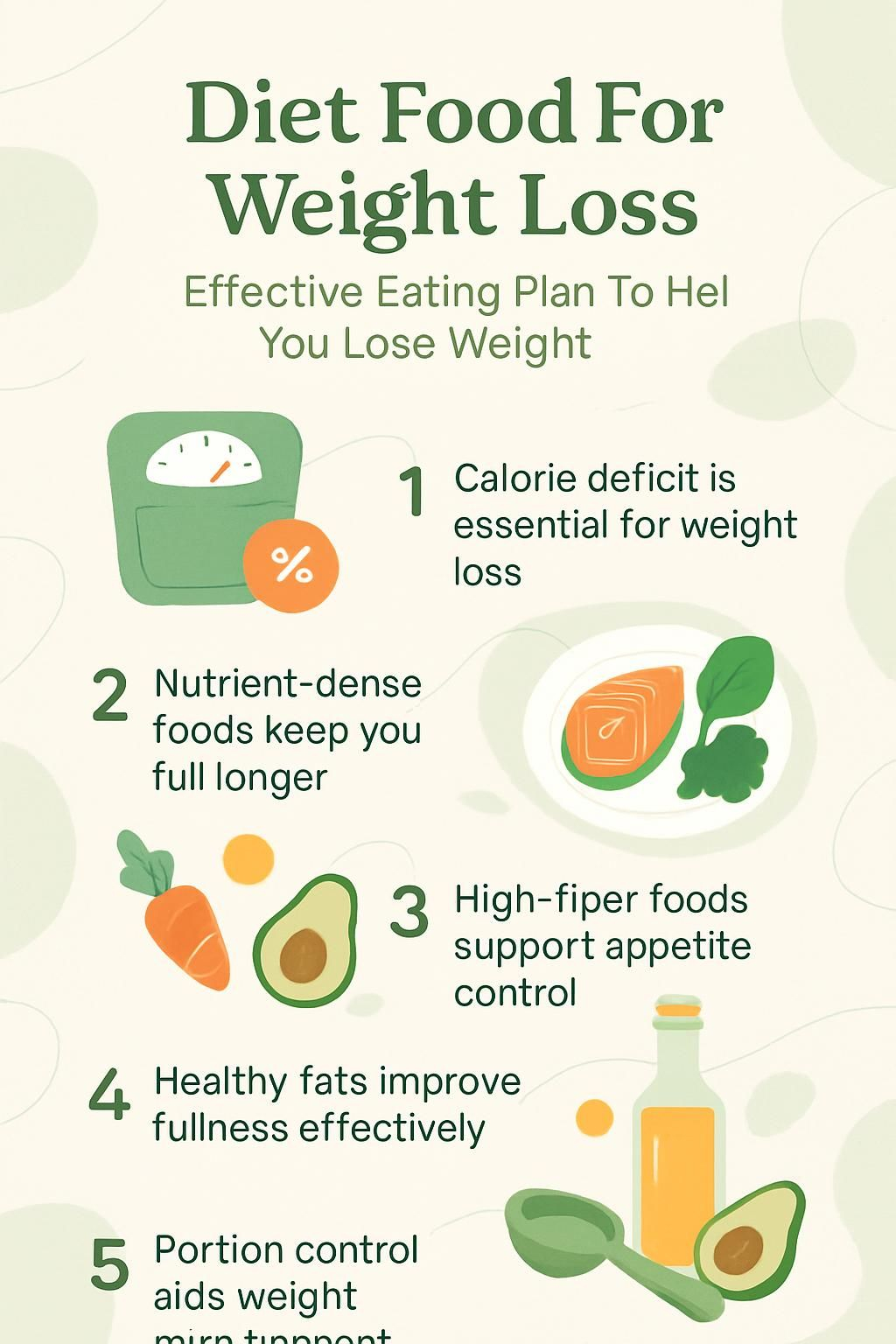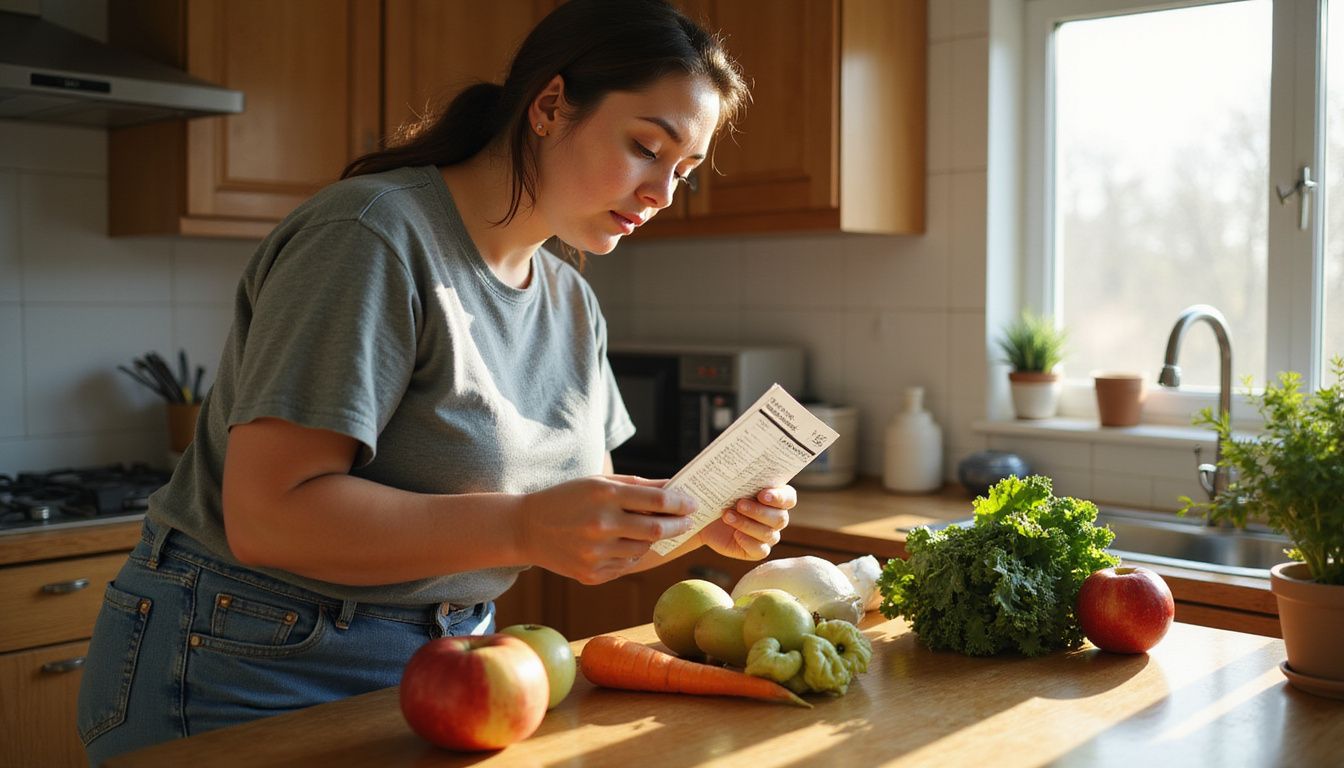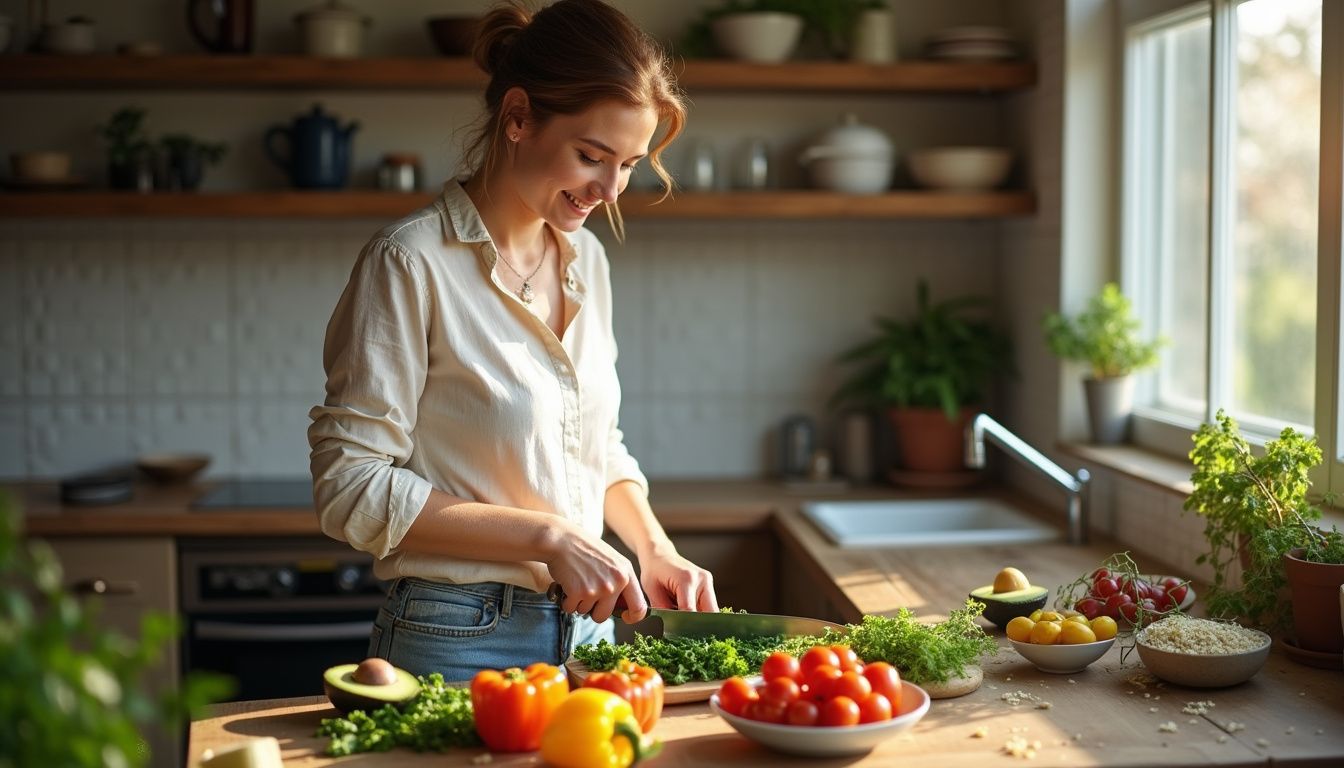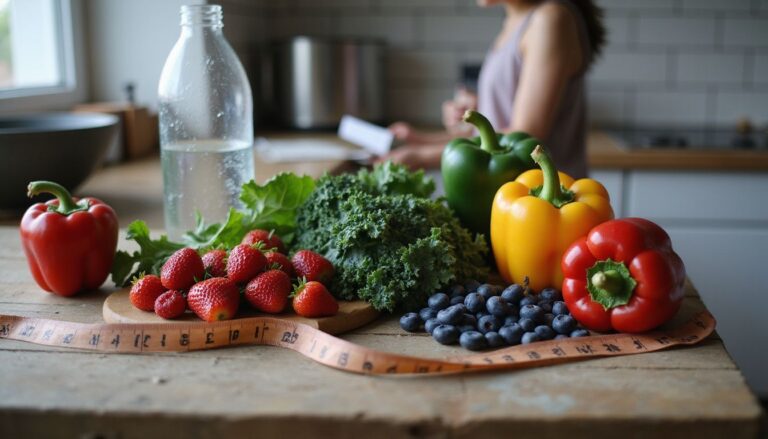Diet Food For Weight Loss: Effective Eating Plan To Help You Lose Weight
Our Nutrition Assistant AI Suite will transform your body. You will lose fat, get toned, and build muscle. Gain confidence and optimal health.
You want to lose weight without feeling hungry all day. A smart eating plan focuses on eating fewer calories while choosing foods that give you more nutrition per bite. This approach supports healthy weight, steady energy, and better habits that last.
Build your meals around lean protein, fruits and vegetables, whole grain choices, and healthy fats. These foods help you feel full longer and make it easier to stay in a calorie deficit. In this guide, you will find practical tips, simple meal ideas, and evidence-based picks that support weight management.
Small tweaks add up. Use the steps below to shape an eating plan that fits your life and helps you lose weight with confidence.
Key Takeaways
- Weight loss needs a calorie deficit, meaning you eat fewer calories than you burn each day, as noted by Mayo Clinic dietitians and the 2020–2025 Dietary Guidelines for Americans.
- Nutrient-dense foods like leafy greens, berries, whole grains, and lean proteins keep you full while delivering key vitamins and minerals for fewer calories.
- High-fiber foods such as beans and lentils, chia seeds, and cruciferous vegetables improve satiety and can support fat loss.
- Healthy fats from avocados, extra virgin olive oil, nuts, and fatty fish help fullness without adding excess saturated fat.
- Practice portion control, space meals every three to five hours, swap processed snacks for high-protein breakfasts or soups, and stay active for better weight management.

Understanding the Basics of Weight Loss

Weight loss begins with how your body turns food into energy. Knowing the basics makes it easier to build a healthy eating plan and stick with it.
What is a calorie deficit and why does it matter?
A calorie deficit happens when you eat fewer calories than your body uses in a day. Your body then draws on stored fat for energy. This step is essential for losing weight, no matter which diet style you follow.
Food choice matters. One cup of grapes has about 104 calories, while one cup of raisins has about 480. Picking lower calorie, high-volume foods makes a deficit easier.
Fill your plate with high-fiber vegetables and lean protein. These foods help you feel full while keeping total calories in check. Without a consistent deficit, even very healthy foods will not lead to steady weight loss.
Why are nutrient-dense foods important for weight loss?
Nutrient-dense foods pack vitamins, minerals, and fiber with fewer calories. Guidelines from the Mayo Clinic and the 2020–2025 Dietary Guidelines encourage these choices for a healthy diet and weight control.
Examples include fresh fruit, leafy greens, broccoli, beans, and whole grains such as oatmeal or brown rice. These foods have water and fiber, which boost fullness and help control blood sugar. Low-fat dairy like cottage cheese or yogurt adds protein with little saturated fat.
Swapping processed snacks for nuts or seeds often leads to longer satiety. Choosing lower calorie, nutrient-rich options lets you enjoy a satisfying portion while supporting heart health.
Choosing nutrient-dense foods helps your body get key nutrients without extra calories.
Key Components of an Effective Eating Plan
The right mix of foods helps you feel satisfied and meet your goals. Learn to balance macronutrients, watch portion size, and build simple routines you can keep.
How to balance macronutrients for weight loss
Macronutrients are protein, carbohydrates, and fats. A balanced plate helps with fullness, muscle protection, and steady energy.
- Protein: lean meats, fish such as salmon or tuna, eggs, tofu, and legumes. Protein supports muscle and curbs hunger.
- Carbohydrates: oats, brown rice, quinoa, and whole-wheat bread. Whole grains add fiber and nutrients.
- Fats: choose unsaturated fats, including avocados, nuts, seeds, and olive oil. Limit foods high in saturated fat.
Many people do well with a Mediterranean-style pattern. It favors plants, seafood, and olive oil while keeping added sugars low.
What is portion control and how can it help?
Portion control means eating an amount that matches your needs. Calorie comparisons can guide choices. A small order of fries has about 250 calories, roughly the same as 10 cups of spinach plus strawberries and one small apple combined.
Use measuring cups at home for a week to recalibrate your serving size. Pick low energy dense foods, which let you eat more volume for fewer calories. One ounce of nuts is satisfying, but portions matter because calories add up quickly.
At home, measuring pasta and cereal helped me avoid overeating, even on busy days. Small habits like this protect your progress.
When should I eat meals for optimal weight loss?
Meal timing supports appetite control. Eating every three to five hours can stabilize hunger and blood sugar. A protein-rich breakfast, like eggs with whole-wheat toast, tends to keep you fuller longer than a sugary cereal and juice.
Starting lunch or dinner with a broth or tomato-based soup increases fullness and can reduce total calories at the meal. Slow eating also helps you notice fullness sooner.
Best Diet Foods for Weight Loss
Choosing the right foods makes weight-loss more doable. Focus on fresh produce, lean protein, healthy fats, and whole grains. These options offer key nutrients for your eating plan.
Which fruits and vegetables aid weight loss?
Fresh produce is low in calories and high in fiber and water, which supports digestion and heart health.
- Strawberries, about 50 calories per cup, deliver water and fiber for fullness.
- Blueberries supply antioxidants and fiber for satisfying snacks.
- Grapefruit is about 90 percent water and only 64 calories per half fruit.
- Leafy greens like spinach, arugula, and kale are rich in vitamins A and K with very few calories.
- Cruciferous vegetables such as broccoli provide fiber and protective micronutrients.
- Citrus fruits like oranges add vitamin C and hydration with modest calories.
- Apples supply pectin, a fiber that slows digestion, and plenty of water.
I began taking raw vegetables to work instead of chips. My energy felt steadier within days.
Why include leafy greens in your diet?
Kale, spinach, and collards are low in calories and high in fiber. They help you feel full without adding many calories to your day.
Leafy greens provide vitamins K and C and folate. They also contain thylakoids, plant compounds that may help manage appetite. A large salad with kale or spinach is an easy way to add volume and nutrients to lunch or dinner.
How do cruciferous vegetables support weight loss?
Broccoli, cauliflower, and cabbage are high in fiber and low in calories. Filling half your plate with these options can reduce hunger between meals.
In one study of 460 people, higher fiber intake was linked to lower body fat over time. Swapping riced cauliflower for white rice made my stir-fries more filling for fewer calories.
What benefits do berries and citrus fruits offer?
Berries such as strawberries and blueberries are sweet, low in calories, and rich in fiber and vitamin C. Citrus fruits, including oranges, bring flavor and hydration without much added sugar.
These fruits support fullness and provide potassium and folate. Choose fresh fruit for snacks or dessert to tame a sweet tooth while supporting your goals.
What lean proteins are best for losing weight?
Lean proteins keep you full and protect muscle as you lose weight.
- Skinless chicken breast, about 31 grams of protein per 100 grams, with very little saturated fat.
- Tuna and salmon, rich in protein and omega-3 fats. A 3-ounce salmon serving has about 22 grams of protein.
- Eggs, about 6 grams of protein each, plus vitamin D and choline.
- Beef tenderloin or flank steak, higher in iron and B vitamins with less saturated fat than many cuts.
- Tofu, about 10 grams of protein per half cup, is a complete plant protein.
- Lentils, about 9 grams of protein per half cup cooked, also add fiber.
- Greek yogurt, about 17 grams per cup, is higher in protein than regular yogurt.
Each option supplies important nutrients while limiting extra calories from saturated fat or added sugars.
Is chicken breast a good protein choice?
Skinless chicken breast is a strong pick. A 3-ounce cooked portion has about 26 grams of protein, less than 3 grams of total fat, and only about 1 gram of saturated fat.
Choose baking, roasting, grilling, or sautéing to limit extra oil. Swapping fried chicken for baked chicken helped me stay full longer without a jump in calories or sodium.
How do fish like salmon and tuna help weight loss?
Salmon and tuna offer high-quality protein that supports fullness and muscle. They also provide omega-3 fatty acids, which support metabolic health.
These fish are good sources of iodine, a mineral that supports thyroid function and a healthy metabolism. A simple dinner of grilled salmon with leafy greens or canned tuna over quinoa makes a quick, nutrient-dense meal.
Are eggs effective for weight loss?
Eggs deliver protein and healthy fats that improve satiety. In a controlled study, a breakfast with eggs and toast led to greater fullness for hours compared to cereal with milk and juice.
Eggs also contain vitamins B12 and D. Adding eggs to breakfast or lunch can lower mid-morning cravings and help you meet your calorie target.
Can tofu and legumes support your diet plan?
Yes. Tofu supplies complete plant protein and fits many meals. Legumes such as lentils, black beans, and chickpeas provide protein plus fiber, which slows digestion and increases fullness.
One cup of cooked lentils contains about 18 grams of protein and 15 grams of fiber. Resistant starch in legumes may further aid appetite control.
Which whole grains are ideal for weight loss?
Whole grains support satiety and blood sugar control better than refined grains.
- Oats, about 4 grams of fiber and 6 grams of protein per cooked cup.
- Brown rice, slower digesting than white rice and a source of magnesium.
- Quinoa, a complete protein, about 8 grams per cup cooked.
- Whole-wheat bread, steady energy with more fiber than white bread.
- Barley, rich in beta-glucan fiber that supports cholesterol and fullness.
- Buckwheat, a gluten-free option rich in antioxidants and magnesium.
- Farro, a chewy grain with iron, B vitamins, and notable fiber.
These choices help curb cravings for sugary or high-fat snacks and support a sustainable eating pattern.
Why choose brown rice as a whole grain option?
Brown rice retains the bran, which adds fiber, minerals, and a nutty taste. A cooked cup provides roughly 3.5 grams of fiber and 5 grams of protein with very low sodium if unsalted.
Pair it with chicken or beans to steady energy and reduce afternoon crashes. I noticed better satiety when I shifted from white rice to brown rice in simple bowl meals.
How does quinoa contribute to weight loss?
Quinoa gives you protein and fiber in one grain. A cup of cooked quinoa has around 8 grams of protein and 5 grams of fiber, which support fullness and slow digestion.
Use it in salads, warm bowls, or as a side for fish or chicken. After swapping white rice for quinoa, my energy stayed more stable between meals.
Is oatmeal a good breakfast for losing weight?
Yes. Oatmeal is filling and nutrient-dense. A cooked cup has about 4 grams of fiber and 6 grams of protein.
Whole grain oats digest slowly, which helps prevent blood sugar spikes and mid-morning snacking. Top with berries or a spoon of nuts or seeds for extra fiber and healthy fats.
Does whole-wheat bread fit into a weight loss diet?
Whole-wheat bread works well for weight loss when portions are mindful. A typical slice has 70 to 80 calories and around 2 grams of fiber.
Whole grains offer steady energy and better fullness than white bread. I switched to whole-wheat bread and found I had fewer cravings later in the day.
What healthy fats should I include in my meals?
Healthy fats improve fullness and make meals taste better. Use them in small amounts.
- Avocados provide monounsaturated fat and fiber. One medium avocado has about 15 grams of fat.
- Extra virgin olive oil, central to the Mediterranean Diet, is rich in monounsaturated fat. Use for salads or low to medium heat cooking.
- Nuts such as almonds and walnuts offer healthy fats and protein. One ounce has about 14 to 20 grams of fat.
- Seeds like chia add omega-3 fats and fiber. Two tablespoons have about 7 grams of fat.
- Fatty fish including salmon, tuna, and mackerel provide omega-3s that support fullness.
- Olives add flavor and monounsaturated fat with modest calories.
- Nut butters can enrich oatmeal, toast, or apple slices. Measure to manage calories.
Adding half an avocado to breakfast helped me stay satisfied until lunch.
How do avocados benefit weight loss?
Avocados combine fiber, water, and healthy fats that slow digestion and support fullness. One medium fruit provides about 10 grams of fiber, plus fats that help your body absorb fat-soluble vitamins A, D, E, and K.
Portion size matters because calories add up fast. Add slices to whole-wheat toast or salad for a satisfying, balanced meal.
Why eat nuts and seeds for weight management?
Nuts and seeds supply unsaturated fats, plant protein, and fiber that steady energy and curb hunger. A small handful fits most plans and can replace less filling snacks.
Research links regular nut intake with better weight outcomes over time. I started sprinkling sunflower seeds on salads and noticed fewer afternoon cravings.
What makes olive oil a healthy fat choice?
Extra virgin olive oil is rich in monounsaturated fat and antioxidants. One tablespoon has about 10 grams of heart-friendly fat.
People who use olive oil in place of butter often see better heart markers. Drizzle on vegetables, whole grains, or lean protein to boost flavor and satiety.
Which low-calorie, high-fiber foods help with weight loss?
Low-calorie, high-fiber picks fill your plate without many calories.
- Air-popped popcorn, about 30 calories per cup.
- Beans and lentils, with up to 15 grams of fiber per cup cooked.
- Leafy greens such as spinach, kale, and lettuce.
- Cruciferous vegetables like broccoli, cauliflower, and Brussels sprouts.
- Chia seeds, about 5 grams of fiber per tablespoon.
- Mushrooms, fewer than 25 calories per cup.
- Citrus fruits, such as an orange, under 70 calories each.
- Nuts like almonds or walnuts, in small portions.
- Whole grains such as oatmeal for slow-digesting carbs.
How do chia seeds support weight loss?
Chia seeds are rich in fiber and omega-3 fats. Fiber helps you feel full, which can reduce total calories later in the day.
In a 2017 study, adding 7 to 14 grams of chia to yogurt increased fullness and led to lower calorie intake at the next meal. Higher fiber intake has also been linked to lower body fat in larger population studies.
Stir chia into oatmeal, smoothies, or yogurt for a simple boost.
Can beans and lentils aid in losing weight?
Yes. Beans and lentils combine protein and fiber, which slow digestion and reduce hunger. One cup of cooked lentils has about 18 grams of protein and 15 grams of fiber.
Resistant starch in legumes may reduce the calories your body absorbs and improve satiety. Adding black beans or chickpeas to salads kept me full through the afternoon.
Are mushrooms good for weight loss diets?
Mushrooms are very low in calories and provide minerals like selenium and potassium. They are low energy dense, meaning you get more volume for fewer calories.
Use them to replace part of the meat in recipes or to bulk up salads and stir-fries. People who choose low-calorie, nutrient-dense foods tend to do better on weight loss plans.
Foods that Boost Metabolism for Weight Loss
Some foods may nudge your metabolism, like turning up a dimmer switch. Small effects can still help when you pair them with a calorie deficit.
How do chili peppers (capsaicin) increase metabolism?
Chili peppers contain capsaicin, the compound that makes them spicy. Capsaicin can increase body heat for a short time, which slightly raises calorie burn as your body cools down.
It may also reduce appetite and increase fat use for energy. While the effect is modest, peppers and spicy sauces can be helpful in a balanced plan.
What are the benefits of green tea for weight loss?
Green tea contains catechins, a type of antioxidant. Catechins may help your body use fat for energy more efficiently. Green tea also has caffeine, which offers a mild boost in alertness and activity.
I switched from sugary drinks to unsweetened green tea and cut calories without losing flavor. It became an easy daily habit.
Can Greek yogurt boost metabolism?
Greek yogurt is high in protein, which increases the calories you burn during digestion, a process called the thermic effect of food. A 6-ounce serving of plain, nonfat Greek yogurt provides about 15 to 20 grams of protein.
Many varieties also contain probiotics that support a healthy gut. A balanced gut microbiome is linked to better metabolic health over time. Choose plain versions and add fruit for sweetness.
Which water-rich foods help with weight loss?
Foods with high water content add volume to meals without many calories.
- Grapefruit, about 90 percent water and 64 calories per half fruit.
- Watermelon, about 92 percent water and roughly 46 calories per cup.
- Cucumbers, around 96 percent water, great for large, low-calorie portions.
- Celery, nearly 95 percent water with about six calories per stalk.
- Strawberries, about 91 percent water and under 50 calories per cup.
- Tomatoes, around 94 percent water and fewer than 25 calories each.
- Lettuce, over 95 percent water, ideal for bulking up plates.
Use these foods to build larger, more satisfying meals while keeping calories in check.
Tips for Building a Sustainable Eating Plan
Habits matter as much as the foods you pick. These steps help you build a routine you can keep without feeling deprived.
How does filling half your plate with vegetables help?
Filling half your plate with vegetables reduces calories while increasing portion size and nutrients. Vegetables have water and fiber, which help you feel full longer.
In a Harvard study, people who ate more fruits and vegetables lost more weight. At dinner, I started adding roasted cauliflower and a big salad to cover half my plate. Cravings dropped within two weeks.
Why should I include protein in every meal?
Protein supports fullness and helps maintain muscle, which keeps metabolism stronger during weight loss. Include a source at each meal, such as chicken, fish, eggs, Greek yogurt, tofu, or beans.
Adding a protein-rich snack, like hummus with vegetables or a hard-boiled egg, can reduce afternoon cravings and steady energy.
What are the effects of avoiding sugary drinks and processed foods?
Cutting sugary drinks and ultra-processed snacks lowers calorie intake fast. Soda, energy drinks, and packaged sweets add sugar and fat without keeping you full.
Choosing whole foods like fruits, vegetables, lean protein, and whole grains gives you more nutrients and fiber per bite. This helps control hunger hormones and supports steady progress.
What healthy cooking methods support weight loss?
How you cook can raise or lower calories. Choose baking, roasting, grilling, or sautéing. These methods use minimal oil and preserve nutrients.
Skip deep frying, which adds many calories and can create harmful compounds. I moved from fried to baked fish last year, and dinners felt lighter without losing flavor. A non-stick pan helps you use less oil when sautéing.
Common Questions About Diet Foods
These quick answers address common concerns. Use them to fine-tune your plan.
What foods help burn belly fat?
No single food targets belly fat, but a pattern rich in protein and fiber helps reduce overall body fat. Eggs, Greek yogurt, chicken breast, salmon, legumes, oats, beans, lentils, berries, leafy greens, and cruciferous vegetables improve fullness and support a calorie deficit.
I ate eggs with oats for breakfast for two months and noticed less snacking before lunch. Reducing sugary drinks and processed snacks supports visible change in the midsection as well.¹
¹Source: National Institutes of Health (NIH), 2023
Can I lose weight without cutting carbs?
Yes. You can lose weight while eating carbs if you choose whole sources and watch portions. The Mediterranean Diet includes oats, brown rice, quinoa, fruits, and vegetables and still supports weight loss.
Whole grains keep you full longer due to fiber. Swapping white bread for whole-wheat bread and filling half your plate with vegetables can improve results.
^1 Source: Harvard T.H. Chan School of Public Health – The Nutrition Source (2023): “Carbohydrates and Blood Sugar.
How much protein do I need daily for weight loss?
Include a source of protein at each meal and snack. A simple rule is to fill about one quarter of your plate with protein-rich foods like chicken, fish, eggs, Greek yogurt, tofu, or beans.
This supports fullness and helps maintain muscle as you lose weight. If you want a precise target, ask a registered dietitian to set a daily gram range based on your body size and activity.
Lifestyle Tips to Support Weight Loss
Eating well is the base. Daily habits like movement, hydration, and sleep help your plan work better.
How does regular exercise complement your diet?
Exercise burns calories and helps preserve muscle while you lose fat. The CDC recommends at least 150 minutes of moderate activity each week for adults.
Walking, cycling, or swimming can raise your daily burn and improve energy. When I added a brisk morning walk, my progress became more steady.
Why is staying hydrated important for weight loss?
Thirst can feel like hunger. Drinking enough water reduces random snacking and supports your metabolism. Water-rich foods like grapefruit and cucumber also add volume for few calories.
Aim for about eight cups of fluids daily from water, unsweetened tea, or water-rich foods. Proper hydration helps your body burn fat more efficiently.
How does getting enough sleep affect weight loss?
Adults need seven to nine hours of sleep per night. Poor sleep raises ghrelin, the hormone that increases hunger, and lowers leptin, the hormone that signals fullness. This can lead to overeating the next day.
In a University of Chicago study, sleeping 5.5 hours reduced fat loss by 55 percent compared with 8.5 hours during calorie restriction. Prioritizing sleep supports better choices and steady progress.
Conclusion
Nutrient-dense foods help you feel full and support healthy weight loss. Lean proteins such as eggs, chicken breast, and fish protect muscle, while leafy greens, berries, beans, and whole grains deliver fiber for lasting fullness. Healthy fats from avocados, nuts, and olive oil make meals satisfying without excess saturated fat.
Use portion control, fill half your plate with vegetables, and plan meals every three to five hours. Pair your eating plan with regular exercise, hydration, and good sleep. For medical conditions or detailed targets, talk with a healthcare professional or a registered dietitian. With steady habits and smart food choices, you can build a plan that helps you lose weight and keep it off.
FAQs
1. What are the best foods to include in a diet for weight loss?
Choose whole grains, lean poultry, fish, beans, leafy greens, and fruits with high fiber. These foods help you feel full longer and provide important nutrients. Studies show that diets rich in vegetables and protein can support healthy weight loss.
2. How does an effective eating plan help with losing weight?
A structured eating plan controls calorie intake while ensuring balanced nutrition. Tracking portions and choosing nutrient-dense options like brown rice or grilled chicken helps reduce excess calories without sacrificing health.
3. Can I lose weight by only changing my food choices?
Food selection plays a key role; however, research shows combining dietary changes with regular movement leads to better results than diet alone. For example, after switching to more plant-based meals and walking daily for thirty minutes, I noticed steady progress over several weeks.
4. Are there specific foods that boost metabolism during weight loss?
Some studies suggest spicy peppers or green tea may slightly increase metabolic rate due to their active compounds such as capsaicin or catechins. However, these effects are small compared to the impact of overall calorie control and consistent meal planning.
Summary: Choosing nutrient-rich foods like whole grains and lean meats supports healthy weight management when paired with portion control and physical activity. While certain items may offer minor boosts in metabolism according to evidence-based sources, long-term success depends on sustainable habits rather than single “superfoods.”







